As an Amazon Associate I earn from qualifying purchases.
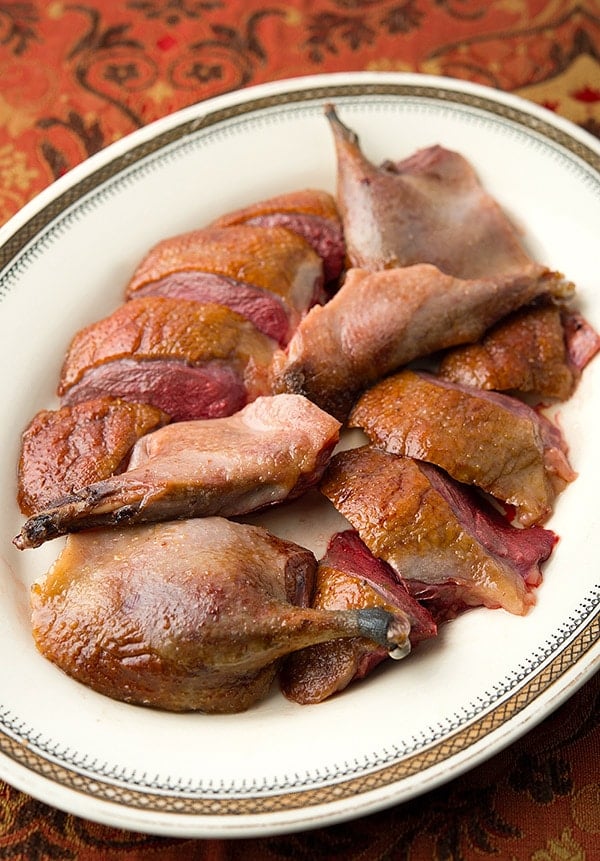
A perfect, whole roast wild duck is more of an idea than a reality.
It is virtually impossible to get that mystical combination of crispy skin, tender meat and just enough fat to make things interesting just by roasting a bird in an oven. You either get crispy skin and overcooked breast meat, or nicely cooked meat with skin that has not yet had enough time to crisp.
That idea in your head of such perfection is like a teenager’s daydream of some swimsuit model or hot teen idol. Nice, gauzy, but not actually real. No, roasting a duck is more like a marriage: It hinges on compromise.
Let me begin by saying you can’t really pull this off with domesticated ducks or geese, and even some of the hugely fat wild ducks we get here in California’s Central Valley are too fat for this recipe. Fat, as you might know, is an insulator and a lubricant. Too much and it will keep the skin too moist to crisp and shield the meat from the warm caresses of your oven.
So start with any wild duck that has a layer of fat 1/8 inch or less on its breast. Yes, I know that a) this sounds insane to those of you living in migratory states, but believe me, we get such birds here; and b) there’s no way to truly test the actual thickness of the fat without removing the breast.
Suffice to say that if, after plucking, you say to yourself, “Damn, that’s a fat duck!” don’t then use this recipe. Use my slow-roasted duck recipe instead.
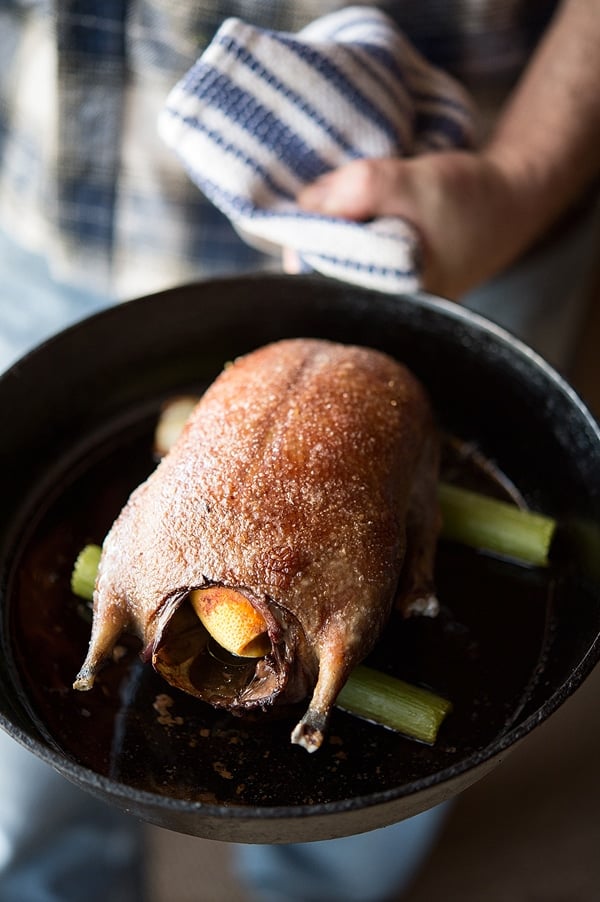
The key to successful roast wild duck is a hot oven. A really hot oven. I never roast whole ducks at less than 400°F and I prefer 500°F. I met someone the other day who roasts at 550° — all I can say to that is he’s got one hell of an oven!
The smaller the bird, the hotter the oven. Teal cook better at about 500°F, while a big mallard, canvasback or small goose (Ross’, cackler, Aleutian, etc) will cook better closer to 450°F. Let your oven preheat a while, too. I have a pizza stone in mine, and I don’t put the bird in the oven until the stone hits the right temperature, which is usually 20 minutes after my oven tells me it’s there.
You also need to decide where you want to be on the continuum of crispy skin to perfectly roasted meat. Obviously the longer you cook the more done your meat will be, and the more crispy your skin will be. Now I like breast meat medium-rare, but only when it’s just the breast. When it’s part of a whole duck, I take it to a solid medium, even medium-well: Still pink, but definitely cooked through.
Why? So the legs can get cooked enough to eat. See? Like a marriage. Compromise.
What you see in these pictures is a whole roasted canvasback, just cooked in a 475°F oven for 22 minutes. Everything is done, but as you can see there are spots on the legs where the skin is not crispy. I don’t mind this, but there is a way to get closer to that perfection, if you are willing to work for it.
Optional Step No. 1: Sear the legs and wings in a pan before you roast the duck. I do this sometimes by putting a little duck fat in the pan I am going to roast the duck in and searing just the legs and wings of the bird while the oven is heating. I do this by holding the whole bird with tongs and continuously moving the bird around to get just the legs and wings, which need a little more time to cook.
Optional Step No. 2: Once your duck has been roasted and rested, carve and then sear the skin to crisp it up. Again, I use the pan I roasted the ducks in, which will have plenty of fat that has come off the birds. This method can be very good when you find out your duck legs are really underdone. A quick sear on the meat side and the skin side usually gets them close to where you want them to be.
When I am just roasting a bird on a weeknight I rarely do the optional steps, but if it’s a special occasion I will often do one or even both.
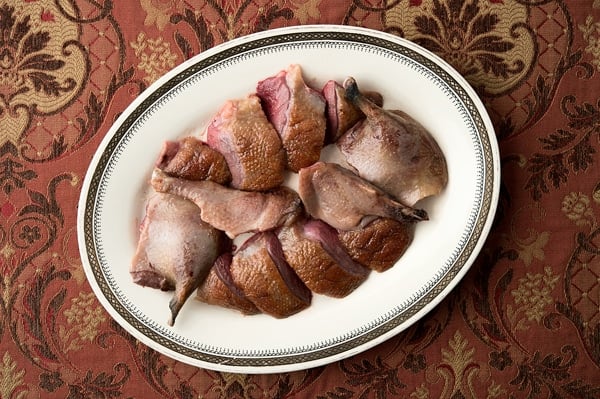
Wild geese can be a little harder to roast. They tend to be older and tougher than ducks, but you can use this recipe easily for small geese such as Ross’ geese, Aleutians or cacklers or smallish specklebelly geese. Large geese, such as normal-sized specklebellies, snow geese and typical Canada geese can be roasted whole, but I don’t really recommend it. Giant Canadas are, in my experience, terrible roasted whole.
As for sauces, I have a selection of wild game sauces elsewhere on this site. And perfect side dishes are mashed potatoes, polenta, roasted potatoes, spaetzle, etc. A good green salad is nice to cut the fattiness of the duck, too.
Here is another way to roast a duck, but this is only if it is very fat.
Like this recipe? I hope you’ll also like my cookbook dedicated to ducks and geese, called, of course: Duck, Duck, Goose: The Ultimate Guide to Cooking Waterfowl, Both Farmed and Wild
Roast Wild Duck
Ingredients
- 4 small ducks (teal wood ducks, wigeon) or 2 to 4 larger ducks
- Lemon or orange wedges
- Salt
- 2 to 3 celery stalks
- Black pepper
Instructions
- Preheat oven to 450°F or higher. I often cook ducks at 500°F, and small ducks are best cooked at these high temperatures. (You can get away with 425°F if that's as high as your oven will go.) Let the oven preheat a good 20 to 30 minutes. Let the ducks rest at room temperature while the oven heats up.
- If the duck is reasonably fat, use a needle to pierce the skin where there is a lot of fat under it: The front of the breast, between the breast and legs, at the flanks, and all over the back of the bird. Be careful not to pierce the meat of the breast. Rub lemon over the bird and dust it with a good salt. Stuff the spent lemon or orange wedge inside the duck.
- Place a few celery stalks onto an oven-proof pan (I use a cast-iron frying pan), arranging them so you can rest the ducks on top. This prevents the ducks from sitting in their own juices. Roast in the oven as follows: About 10 to 15 minutes for teal or other small ducks, 13 to 20 minutes for anything up to the size of a gadwall, 18 to 25 minutes for a mallard or canvasback. The key here is an internal temperature of about 140 to 145°F at the deepest part of the breast meat, which is in the front third of the breast. Don’t have an instant read thermometer? Get one. Ducks need to be cooked medium-rare to medium. An overcooked duck is a sad thing.
- Take the duck out, move it to a cutting board and rest it. Let small ducks rest about 5 minutes. Large ducks need to rest closer to 10 minutes, and geese up to 15 minutes.
- If you want a simple pan sauce, remove the celery and stir a tablespoon or two of flour into the drippings. Let this cook on the stove (you might be able to do this solely with the residual heat in the hot pan until this roux is the color of coffee-with-cream. Add a tablespoon of Worcestershire sauce, some wine or brandy and the juice of a lemon. If the sauce is too thick, add a little water or stock. Whisk everything to combine and add salt to taste. Turn off the heat, add a tablespoon of minced parsley and a knob of butter. Swirl to combine and serve.
Nutrition
Nutrition information is automatically calculated, so should only be used as an approximation.
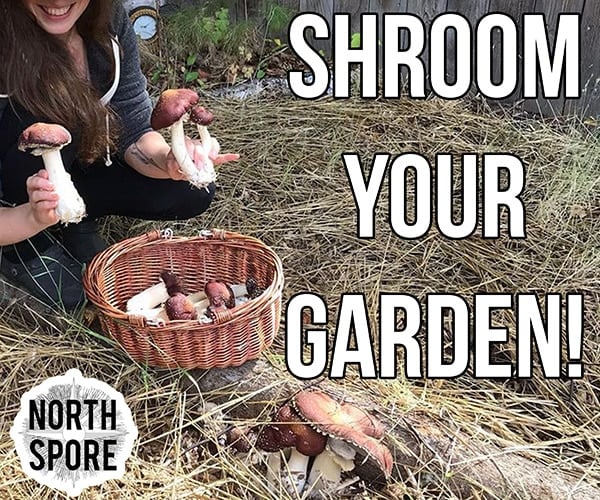

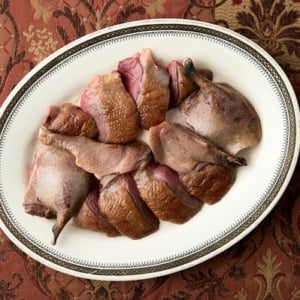

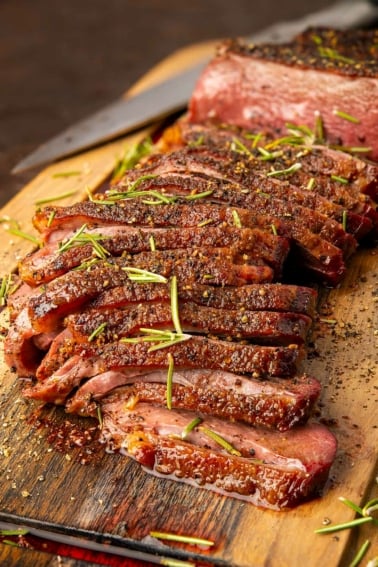
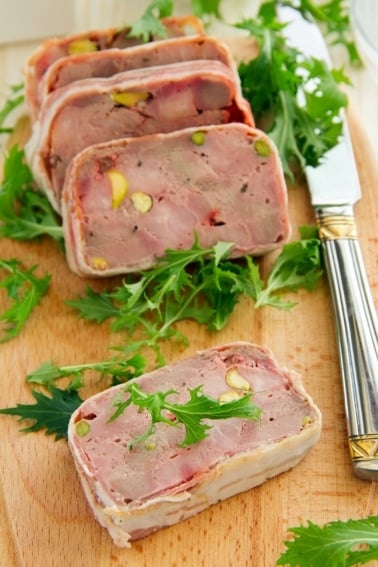

Forgot the celery stalks at the market last night. We substituted sliced red onion. Put them back in the oven to fry in the fat while the pintail rested. Worked out great! Thanks Hank, you’re my new hero!
P.S. Duck, Duck, Goose was on the display/resource table at the CDFW Advanced Hunter Ed Game Care & Cooking Clinic that was in Santa Clara County in September.
When it comes to the stronger tasting divers like mergansers I’ve had some great success with simply breasting the birds slicing up some garlic cloves tossing that into a pan with some olive oil or butter. Pepper salt or something like an all seasoning mix. Adding some sweet red wine to the pan as well. I’ve dished up coot breasts in a similar fashion and merganser for guests and no one was the wiser. No fishy taste not overly gamey. The wine is cheap concord Mogan David nothing special and it definitely does not over power the bird. I decided to get brave one day and try eating mergs and coot. I wanted to know if they were as truly awful as their reputation defined them to be and I was pleasantly surprised as were those who ate them with me.
For mergansers use above recipe in a cedar plank. Pull out of the oven, discard the duck and eat the cedar plank! You’ll be better off than eating a merganser.
As far as cooking fish ducks goes they are certainly stronger than a good Mallard but I have found that a good strong marinade will make them palatable. I use mine in a peanut sauce stir fry with soy sauce, ginger, red pepper, and peanut butter. This combination actually makes for a terrific flavor. If you do pull down a Merganser, Goldeneye, of Bufflehead I would give it a try.
Here is a list of other ducks I won’t shoot because they are hard to eat: all mergansers (though hoodies are the best of a bad bunch, golden eye, spoonies (northern shoveler), all sea ducks: eider, scoter etc. We take occasionally under duress: scaup and wigeon. Big canadas are a favorite because we don’t have to pluck, just breast to make jerky and heavily marinated satay out of the breast, and save up the legs and thighs to crock pot into “pulled goose” sandwich meat.
I’m glad I your website! My girlfriend shot a couple of mergansers last season and I don’t have much experience with cooking game meat. I cut it up today and whipped up a marinade for them. It has such a fishy smell! I didn’t know if that was right. I’m making Asian tacos with the mergansers but I look forward to trying the mallard that’s still in the freezer. I’m excited to explore you website more. Thanks!
Nancy: Toxins in the skin is not an issue with occasional eating. I might be more concerned if I were planning eating 15+ of these geese in a season, however. But double check with the NY DEC or the fish and wildlife agency. They might have a health warning on them.
My son shot us a nice goose today. His father insists that it is not safe to eat the skin in a wild bird as all the toxins are held in the fat. We live on Long Island NY a suburb of NYC. I guess it is probably not the most pristine environment but it is not in Times Square either. They are non-migrating birds. What does anyone think? It is air drying in the fridge to cook in 4 days. Help, I need answers soon!
For those wishing to start such a recipe but have a bird that’s too fat, the trick used in both Cantonese (shao ya) and Peking/Beijing duck roasting technique is to blanch the duck for a few minutes in a pot of boiling water before glazing and roasting it. Haven’t done this myself but it’s probably worth a try.
I like to throw my oven over to high broil for the last couple minutes…does wonders to crisp that skin up right at the end.
Thank you for posting these guidelines. In them you mention a number of species of duck and goose that I take are North American. Coming from the other side of the pond, however, I was wondering what you think is the best way of cooking a greylag of around 4lbs. Is that considered a small bird that is, therefore, suitable for roasting whole or should one remove the breasts halfway to stop them overcooking?
Hank –
Agree with you regarding roasting a Giant Canada, not good…I do have a question tho’, do have a method for rendering fat from a skinned goose (or fat mallard for that matter)? With our liberal Canada goose limit it seems a shame to lose all that fat to skinning.
Thank you for posting this. I may be going out duck hunting for the first time this year, and I love well-made duck… problem is, I have little experience making duck and the few times I bought it I borked it. But your advice seems solid and I’m excited to try it.
One comment I have about the fishy taste of mersangers, is I wonder if a better result would be had if mersangers were treated as a fish dish. I love squid in thai curry (it has to be the Maesri brand for me, and if I wasn’t using squid I was using chicken). I also loved eating fish stews in Japan (where the heads of the fish stared at you and the shells were all attached to everything), canned sardines in oil with olives, etc… But I’m not really sure what is referred to as a fishy taste… sometimes that means an ammonia taste, as in rotting fish?
Thanks!
I thought the same thing about the Hooded Merganser! Kudos!!
I would just add for those starting out.. I like to get all the stuff out of the body cavity when dressing a roasting duck by splitting it down the back,(once its plucked and singed)from neck to tail, clean out the kidneys/lungs from the ribs etc and it still looks great roasted breast side up. Hank, you’re doing the world of new hunters a big favor with this blog. Whats the point if its not good to eat? Am I the only one who uses a propane torch to singe after dry plucking?
Chris: OMG. You plucked and roasted a merganser?! Wow. You are a better man than I am. I never shoot them because all they eat are fish, which does make them taste fishy. And you are right, they stink. Bad. Do yourself a favor and never shoot one again. I promise that you will like your next duck a lot better, so long as it’s not a goldeneye, spoonie or bufflehead… 😉
I found your website two weeks ago after shooting my first duck (male Hooded Merganser). I decided to try this roasted duck recipe to see how it would taste. Interesting. It had a strong smell as it cooked (fishy?). I’m guessing it has to do with it’s diet. Anyway, I was hoping for that crispy skin and tender breast, but you’re right about the compromise. The taste was strong, but not overwhelming. I also had a hard time getting the internal temperature up to 145F after 20 minutes even with the oven at 520F.
Great site! I’ll be stopping by often.
Chris
Peter: I rarely pluck snow geese or Ross’, but I did enough times to realize why I break out the skinning knife these days. Lotta work for weird blue skin and no real fat.
Linda: I never stuff birds, as there is just too high a risk of pathogens, or of a wildly over cooked (or undercooked) bird. If you *must* stuff your bird, follow the Slow Roasted Duck recipe that I link to at the bottom of the post. That will work.
With these cooking times, stuffing seems a near impossibility. Any thoughts on how to include the stuffing (including sausagemeat), maybe by pre-cooking? Am making wild duck (hopefully stuffed) for dinner tomorrow so any tips ASAP will be gratefully received.
I want to try that slow 30 at 300. I remember many years ago my host telling me he was going to cook our ducks as he always did, at least 30 minutes. I resigned myself to the gloomy thought that tender shoe leather would be the outcome, that no duck should stay in an oven that long. I poured me another glass of wine. But, miracle of miracles, the ducks came out just as you said!
But who in this world prepares a whole snow or Ross’s when they are that hard to pluck? Nope, they come under the scalpel with me, saving breasts. legs, livers, hearts and gizzards. Have not yet tried tongues